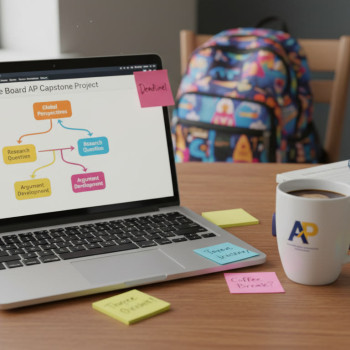Why a Mixed FRQ Day Can Be Your Secret Weapon
If you’re staring down a day that mixes Free Response Questions (FRQs) from AP English Language, AP U.S. History, AP Economics, and AP Psychology, first—deep breath. Mixed FRQ days are challenging, yes, but they’re also the most realistic and highest-yield practice you can do. Collegeboard-designed exams and classroom assessments don’t test subjects in isolation in life, and the mental agility required to switch gears fast is a skill you can and should train.
This guide will walk you through a careful plan: how to structure a full practice day, what to focus on in each subject, how to write clear, high-scoring responses, and how to analyze and iterate on your performance the same way a coach would. I’ll also sprinkle in real-world examples, common pitfalls, and practical tips for using one-on-one supports like Sparkl’s personalized tutoring—only where it fits naturally—to make the most of your practice.
Before the Day: Preparation That Sets You Up to Win
Gather the right materials
- Timed FRQ prompts for each subject (official College Board practice questions are ideal).
- Stopwatch or timer that you trust—phone timers, kitchen timers, or a dedicated study app.
- A place to write longhand or type, depending on how you’ll be tested; practice in the same mode you’ll use on test day.
- Reference sheets (periodic tables for history timelines, economic graphs templates, rhetorical device checklists, key psychology terms).
Create a realistic schedule
Simulate the mental switching you’ll face during a mixed exam day. A suggested schedule for a single practice session might look like this:
| Time Block | Task | Purpose |
|---|---|---|
| 0:00–0:15 | Warm-up: quick review of key terms across all four subjects | Activate recall and focus |
| 0:15–1:00 | AP English Language FRQ (Timed) | Practice rhetorical analysis / synthesis |
| 1:00–1:05 | Short break | Mental reset |
| 1:05–1:45 | AP U.S. History FRQ (Timed) | Practice thesis-driven argument & evidence use |
| 1:45–2:00 | Break + quick review | Recover and prepare to shift modes |
| 2:00–2:30 | AP Economics FRQ (Timed) | Graphing, models, and concise explanations |
| 2:30–2:40 | Stretch break | Restore energy |
| 2:40–3:10 | AP Psychology FRQ (Timed) | Definitions, study design, and application |
| 3:10–4:00 | Scoring review, self-assessment, and targeted revision plan | Consolidate learning and set next steps |
Mindset and logistics
Go into the session with an experimental mindset. Expect mistakes—what matters is how you diagnose and correct them. Eat a balanced meal beforehand, hydrate, and make sure your phone is on Do Not Disturb. Treat the practice like a dress rehearsal for the real thing.
AP English Language FRQ: Crafting Argument and Analysis Fast
What graders are looking for
Clarity of thesis, development of evidence, sophisticated reasoning, and command of language. For synthesis prompts, skillful integration of provided sources is essential. For rhetorical analysis, focus on how language choices produce effects.
Strategy in 40 minutes
- First 3–5 minutes: Read the prompt and annotate the text quickly—underline verbs that define task (analyze, evaluate, describe).
- Next 7–10 minutes: Create a tight outline: thesis, 2–3 body paragraphs, and a short conclusion. Jot a sentence-level plan for evidence in each paragraph.
- Remaining time: Write with intention. Use one concrete example per paragraph and link it clearly back to the thesis.
Example micro-outline for a rhetorical analysis
- Thesis: Author uses juxtaposition and parallel structure to highlight tension between individual rights and collective responsibility, producing a tone of urgent empathy.
- Para 1: Example of juxtaposition—explain effect and diction choice.
- Para 2: Parallel structure—how rhythm strengthens argument.
- Para 3: Ethos/pathos appeals—connect to broader context.
- Conclusion: Re-state significance and tie to the prompt’s task.
AP U.S. History FRQ: Building an Evidence-Based Argument
What graders reward
A clear thesis that directly answers all parts of the question, supporting evidence from the period, and reasoning that connects evidence to the claim. Analysis of continuity and change, causation, or comparison—depending on the prompt—is crucial.
Structure that works
- Thesis in the first paragraph that addresses the prompt and includes a time frame or geographic scope if relevant.
- Each body paragraph begins with a topic sentence that ties back to the thesis.
- Use specific examples (events, legislation, people, dates) and explain how each supports your argument.
- End with a short synthesis or reflection that situates your argument in a broader historical context.
Common mistakes to avoid
- Listing facts without analysis. Facts must be connected to your claim.
- Vague phrasing like “many people” or “some events” without specifics.
- Ignoring part of the prompt—always circle all task words before you begin.
AP Economics FRQ: Clear Models, Clear Thinking
Things to prioritize
Economics FRQs reward precise definitions, accurate graphs, and tight explanations tying model outcomes to the prompt. Label axes, curves, equilibrium points, and show shifts clearly. Even if your graph is rough, a labeled and logically consistent sketch can earn significant points.
Graphing tips
- Label axes: Price (vertical) and Quantity (horizontal) unless told otherwise.
- Show initial and new equilibrium points after a shift; use arrows to indicate direction of movement.
- When asked about welfare (consumer/producer surplus), shade or describe the areas precisely and explain changes in words.
Sample approach to a 20–30 minute Econ FRQ
- 2–3 minutes: Read prompt and note what’s changing (demand shift, supply shock, price control, tax).
- 5–7 minutes: Sketch graph(s) with labels and show initial vs. new equilibrium.
- 10–15 minutes: Write answers, defining terms and explaining causal links. If a calculation is required, show work clearly.
AP Psychology FRQ: Precise Terms and Application
Core strengths to display
Concision and accuracy. Psychology FRQs often ask you to define concepts, design studies, or apply theories to scenarios. Use textbook-accurate terms and be explicit about operational definitions and controls when outlining a study.
Study-design mini-checklist
- State the hypothesis clearly.
- Define independent and dependent variables (IV/DV).
- Describe the participants and sampling method.
- Explain controls and procedures to reduce confounds.
- Include how results would be measured and what analyses would be appropriate (basic description—e.g., compare means).
Transitioning Between Subjects: How to Switch Your Brain Effectively
Micro-resets that work
- 5-minute breathing or walk: Reset attention and prevent cognitive inertia.
- One-sentence summary: Before you finish a subject, write a one-line takeaway that captures the central claim you just made—this helps your brain close the loop.
- Quick checklist: For each subject, have a 3-item checklist you scan before you start (e.g., for Lang: thesis, evidence, conclusion; for Econ: graph, labeling, explanation).

How to Score Your Own FRQs (Honest and Actionable)
A self-scoring rubric you can use
Adopt the actual task verbs from the prompt and create a mini-rubric. For each required element, ask: Did I do what the prompt asked? How well did I support it? Rate on 0–3 and total the score. Be merciless but fair.
Feedback checklist for revision
- Accuracy: Are any facts wrong? If yes, mark and correct immediately.
- Specificity: Could a grader find the evidence you’re citing? Add names, dates, or quotes to be precise.
- Clarity: Is the thesis stated plainly? If not, rewrite it to directly answer the prompt.
- Economy: Are there sentences that don’t help the argument? Cut them.
Table: Quick Tactical Reminders by Subject
| Subject | Key Action | Time Focus | One-Line Tip |
|---|---|---|---|
| AP English Language | Thesis + targeted evidence | 40 minutes | Announce your argument and keep tying details back to it. |
| AP U.S. History | Argument with specific historical evidence | 40–60 minutes | Dates and names matter—use them to anchor analysis. |
| AP Economics | Graph accurately and explain causation | 20–30 minutes | Label everything and narrate the graph’s movement. |
| AP Psychology | Define and apply psychological concepts | 20–30 minutes | Be precise: operationalize variables and name theories. |
Common Pitfalls on Mixed FRQ Days (and How to Avoid Them)
Pitfall 1: Running out of time because of over-perfectionism
Fix: Prioritize the grader’s rubric. Make sure every required element is present before polishing language.
Pitfall 2: Switching costs between subjects
Fix: Use the micro-reset techniques above. A short physical or mental break preserves cognitive flexibility.
Pitfall 3: Being vague when specificity matters
Fix: Keep a cheat-sheet of high-frequency specifics—top 8 events/dates for history, key economic models and labeled graphs, standard psychology studies, and rhetorical devices. Reference it before you start writing.
Integrated Practice: A Sample Mixed FRQ Mini-Session
Try this compact routine once a week in the month before your exam: set a 3-hour block, follow the schedule table above, and score yourself. Track your scores across sessions to identify slow-burn improvements (e.g., thesis clarity in Lang, quicker graphing in Econ). Swap in official College Board prompts where possible to ensure alignment with exam style.
How Personalized Tutoring Can Amplify Your Progress
Working on mixed FRQ days alone is powerful, but one-on-one guidance can accelerate results. A targeted session with a tutor can help you pinpoint recurring errors, get model responses for comparison, and practice pacing under realistic conditions. If you use a service like Sparkl, tutors often provide tailored study plans, focused one-on-one guidance, and data-driven insights to help you prioritize weak spots—whether that’s thesis construction, graph accuracy, or experimental design.
How to Use Your Practice Data to Improve
Track three metrics
- Accuracy: Percentage of rubric elements you hit each session.
- Speed: Time spent per question vs. target time.
- Clarity: A qualitative note about how clear your thesis or main claim was (1–5 scale).
Review these weekly. If accuracy improves but clarity lags, prioritize targeted writing exercises. If speed is the problem, do sprint drills—timed 10–15 minute micro-FRQs focused on the skill you need (e.g., graph labeling or one-paragraph analyses).

Final Tips for Test Day and Last-Minute Prep
- Simulate at least two full mixed-FRQ practice days in the month before the exam, ideally under timed and uninterrupted conditions.
- Practice writing legibly and concisely if the exam requires handwritten answers; clarity still matters even on typed responses.
- Reserve the day before the exam for light review and sleep—avoid cramming. Short, focused review sessions beat marathon study the night before.
- On test day, pace by sections. If you’re stuck on one part, leave a brief placeholder and return—don’t lose time chasing a perfect sentence.
Parting Words: Turn Mixed FRQ Days into Momentum
Mixed FRQ practice is less about mastering one subject and more about becoming a flexible thinker who can read prompts closely, organize responses quickly, and argue with clarity under pressure. Each practice day is a data point—collect them, analyze them honestly, and iterate. Use targeted drills for recurring issues, and when you need focused feedback, consider brief personalized tutoring sessions to break plateaus. With deliberate practice, those skills become second nature: you’ll move from reactive improvisation to confident, strategic response.
Remember: excellence on FRQs doesn’t come from memorizing perfect answers—it comes from training your reasoning, your voice, and your timing. Start small, practice deliberately, and let each mixed FRQ day sharpen the tools you’ll use on test day and beyond.
Good luck—one FRQ at a time.























No Comments
Leave a comment Cancel